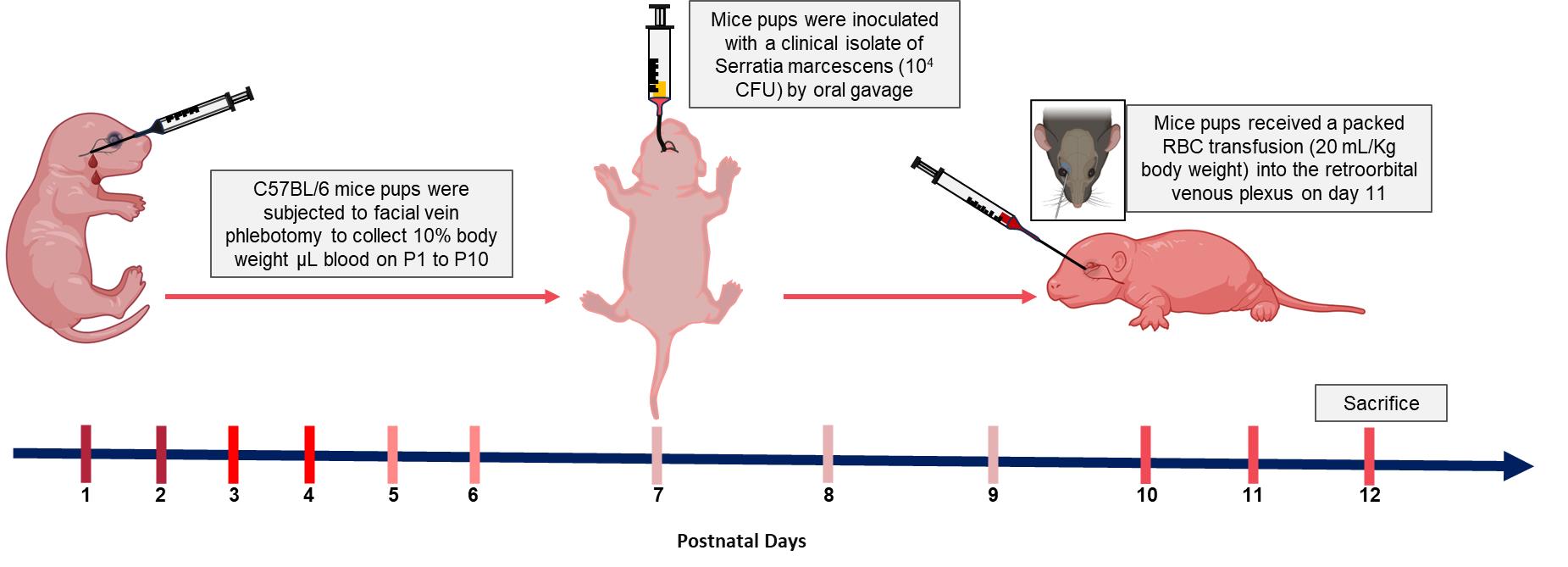- EN - English
- CN - 中文
A Detailed Protocol for the Induction of Anemia and RBC Transfusion–associated Necrotizing Enterocolitis in Neonatal Mice
新生小鼠贫血和红细胞输血相关坏死性小肠结肠炎的详细诱导方案
发布: 2024年05月20日第14卷第10期 DOI: 10.21769/BioProtoc.4993 浏览次数: 2155
评审: Nafisa M. JadavjiDushyant MehraBassam A. Elgamoudi
Abstract
Anemia is a common and serious health problem, nearly universally diagnosed in preterm infants, and is associated with increased morbidity and mortality worldwide. Red blood cell (RBC) transfusion is a lifesaving and mainstay therapy; however, it has critical adverse effects. One consequence is necrotizing enterocolitis (NEC), an inflammatory bowel necrosis disease in preterm infants. The murine model of phlebotomy-induced anemia and RBC transfusion–associated NEC enables a detailed study of the molecular mechanisms underlying these morbidities and the evaluation of potential new therapeutic strategies. This protocol describes a detailed procedure for obtaining murine pups with phlebotomy-induced anemia and delivering an RBC transfusion that develops NEC.
Keywords: Phlebotomy-induced anemia (静脉切开引起的贫血)Graphical overview

Schematic diagram of murine model of anemic and red blood cell (RBC) transfusion-associated necrotizing enterocolitis (NEC)
Background
Red blood cell (RBC) transfusions are necessary and essential therapeutic interventions frequently utilized in the neonatal intensive care unit and to treat critically ill infants who experience severe anemia due to physiologic and iatrogenic factors [1–4]. Nearly 80% of all infants born at <27 weeks of gestational age receive one or more RBC transfusions during their birth hospitalization [5–8]. Though repletion with packed RBC has obvious benefits (such as increased oxygen-carrying capacity), transfusions have also been implicated in the subsequent development of necrotizing enterocolitis (NEC) within 48–72 h after transfusion [7–15]. NEC is the most common acquired gastrointestinal disease of premature neonates, affecting 5%–15% of infants born with <1,500 g [5–8,16–18] and, despite technological advancement, remains a leading cause of death in neonates born between 22 and 28 weeks gestation [9–12,19,20]. NEC is also associated with multiple immediate serious complications, such as death due to sepsis, and long-term complications, including intestinal failure, growth delay, and adverse neurodevelopmental outcomes [21,22]. The causes of NEC are diverse; however, our recent findings documented that phlebotomy-induced anemia resulted in a disproportionate and persistent increase in intestinal permeability in pre-weaned mice because of the disruption of epithelial adherens junctions [23], developing a low-grade inflammatory state in the intestine with prominent macrophage precursor infiltration. Subsequent RBC transfusions activate these macrophages and thus cause NEC-like injury [24]. To examine the pathogenesis of NEC, various murine models have been established. This study will describe an improvement upon the previous version and a detailed protocol of our murine model of RBC transfusion–associated NEC.
Materials and reagents
Biological materials
Serratia marcescens (American Type Culture Collection, catalog number: 13880)
C57BL/6J mice (The Jackson Laboratory, catalog number: 000664)
Reagents
Citrate phosphate dextrose adenine (CPDA-1) (Sigma, catalog number: C4431)
Luria-Bertani (LB) broth (Quality Biological, catalog number: 340004101)
Normal saline (0.9% sodium chloride) (Sigma-Aldrich, catalog number: 7647145)
Trypan blue (Thermo Fisher, catalog number: 15250061)
0.5% Proparacaine hydrochloride ophthalmic solution (Alcon Laboratories, Inc., catalog number: NDC0998-0016-15)
Phosphate-buffered saline (PBS) (Gibco, catalog number: 10010023)
Intestinal fatty acid binding protein ELISA kit (MyBioSource, catalog number: MBS035456)
Laboratory supplies
Cell pack (Sysmex America, model: DCL 300A)
Sterile Acrodisc WBC syringe filter (Cytiva, catalog number: AP-4952)
Magnifier lens
1.5 mL Eppendorf tubes (Eppendorf, catalog number: 022363204)
14 mL culture tube (Corning, catalog number: 352057)
1 mL syringe (Thermo Fisher, catalog number: 309625)
0.3 mL insulin syringe (Becton, Dickinson and Co., model: BD Ultra-Fine II)
Umbili-cath polyurethane UVC catheter, single lumen, 3.5 French (Utah Medical, catalog number: 4183505)
Equipment
Weighing balance (Mettler-Toledo, catalog number: ME104TE)
Sysmex XN-1000TM hematology analyzer (Sysmex Corp, IL)
Spectrophotometer (Molecular Devices, model: SpectraMax Plus)
Procedure
文章信息
版权信息
© 2024 The Author(s); This is an open access article under the CC BY license (https://creativecommons.org/licenses/by/4.0/).
如何引用
Ramatchandirin, B., Balamurugan, M. A., Desiraju, S., Chung, Y. and MohanKumar, K. (2024). A Detailed Protocol for the Induction of Anemia and RBC Transfusion–associated Necrotizing Enterocolitis in Neonatal Mice. Bio-protocol 14(10): e4993. DOI: 10.21769/BioProtoc.4993.
分类
医学 > 发炎
细胞生物学 > 模式生物培养
您对这篇实验方法有问题吗?
在此处发布您的问题,我们将邀请本文作者来回答。同时,我们会将您的问题发布到Bio-protocol Exchange,以便寻求社区成员的帮助。
Share
Bluesky
X
Copy link









